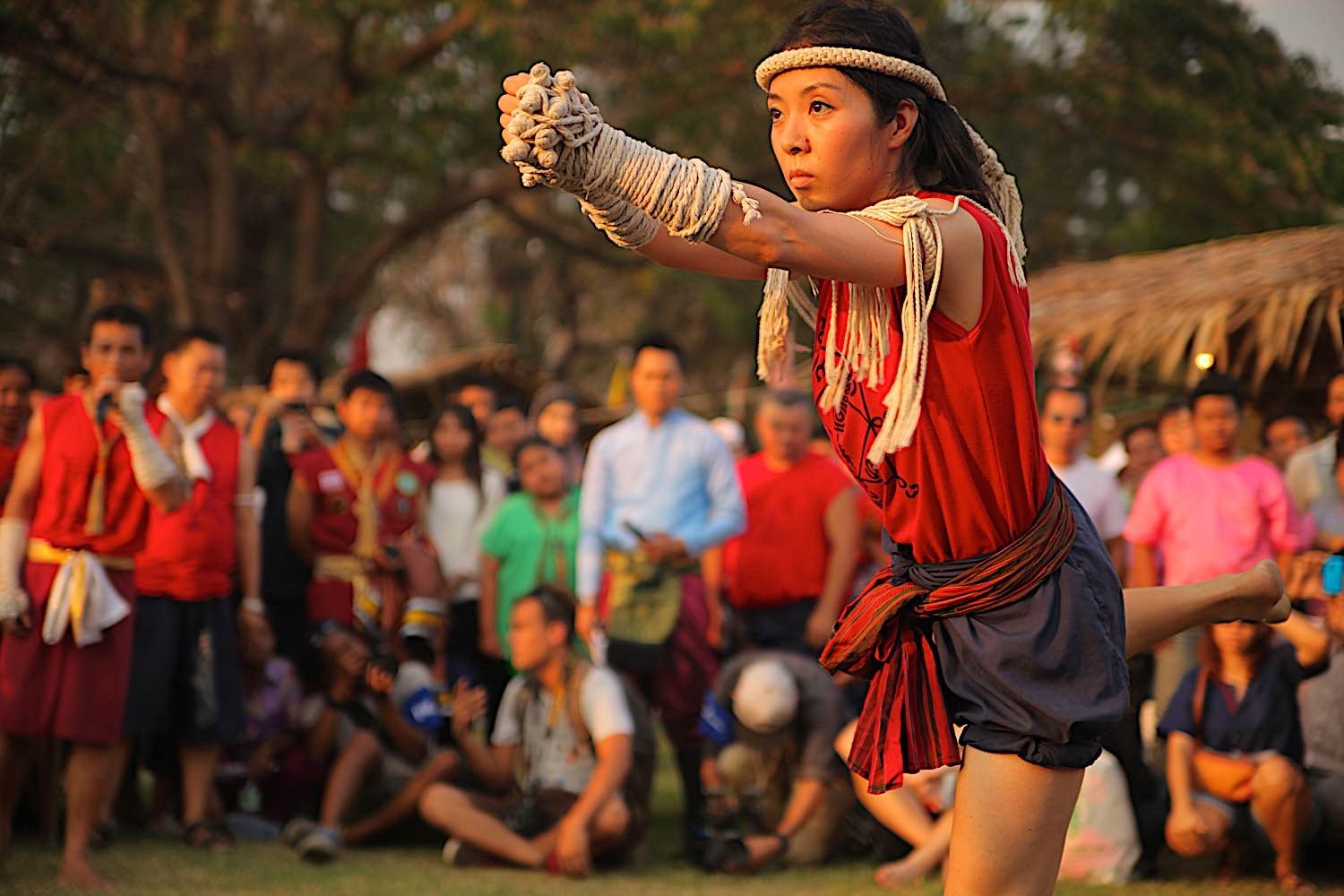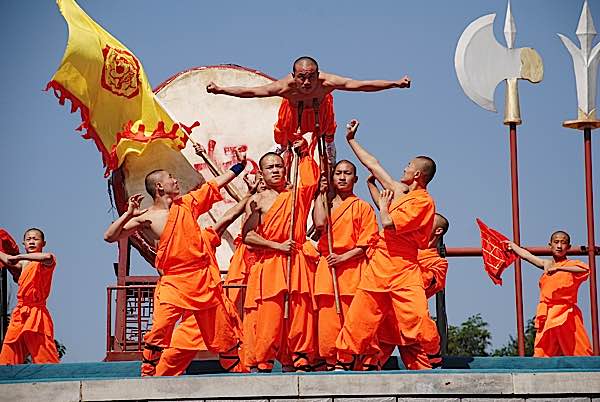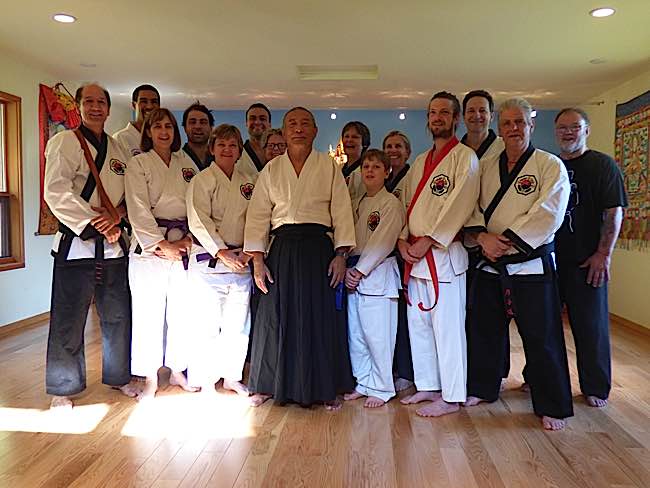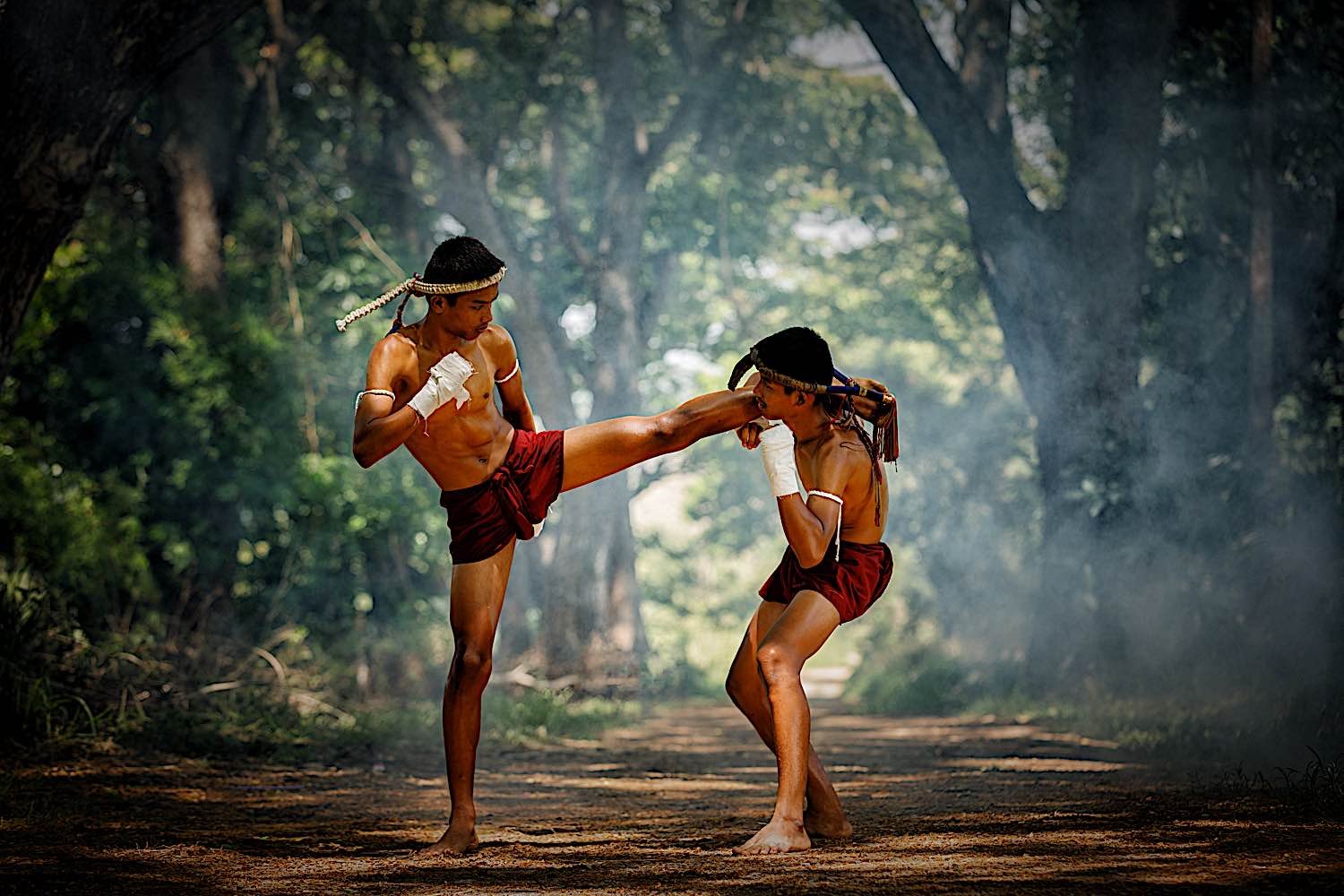Martial Arts and Buddhist practice have at least three things in common: discipline, mindfulness and compassion.
It is often said that Buddhist and martial arts practices are complementary — and sometimes even analogous in method. This may be because both emphasize discipline, mindfulness, and compassion.
The relationship between martial arts and Buddhism has a long history, at least stretching back to ancient India, and later to its association with Shaolin Buddhism in China, or in Japan with Judo’s close alignment with Buddhism. Aside from these links — where martial arts practice is actually wound into and a part of Buddhist practices — they also align in terms of mental discipline and many philosophies. The many forms of both Buddhism and martial arts, share a common goal: to improve oneself both mentally, physically and spiritually.
By Dave Lang

This article will take a closer look at the relationship between Buddhism and martial arts. We will discuss some of the similarities and differences between these two practices and explore how they can complement each other.
- See our previous feature: “Dharma in Motion: Buddhism, Vajrayana Buddhist Tantra and Zen have as much in common with martial arts as religion?”>>

Overcoming fear — both Buddhism and martial arts teach this skill
Martial arts is often taught as a method to help overcome fear. Fearlessness as method is taught in both martial arts — through skills development, practice, repetition — and in Buddhism — through skills development, practice, and repetition. We face our fears in both practices, in remarkably similar ways. In martial arts we have exercises and forms. In Buddhism we have meditation exercises and ritual forms. In both traditions, fear is overcome through experience, experiencing, exercising strength (of both mind and body) and confidence-building. This is only the beginning of the similarities.
Before discussing the relationship between Buddhism and martial arts, it is important to define what we mean by martial arts. Martial arts are a system of codified practices and traditions of training for combat.

While the term “martial arts” is sometimes used to refer to modern sports such as mixed martial arts (MMA), it actually encompasses a much wider range of activities. For our purposes, we will focus on martial arts that emerged in the East, alongside the development of Buddhism.
Some of the most intricately codified martial arts were developed in China, Japan, and Korea. If we take a closer look at some of these disciplines, we can see how they share commonalities with Buddhism. [1]

Kung Fu — is often associated with Shaolin Buddhism
Perhaps the most ‘striking’ similarity between Buddhism and martial arts is the focus on mindfulness or being present in the moment. Kung fu practitioners strive to be completely aware of their surroundings and every movement they make.

This state of complete awareness is sometimes referred to as “mind like water” because, just like water, the kung fu practitioner should be able to flow around any obstacle in their path.
As for the origins of kung fu, legend has it that the discipline was developed by the Buddhist monk Bodhidharma. Bodhidharma is said to have brought Buddhism from India to China in the 5th century CE. [2]

It is believed that he developed a system of physical and mental exercises to help the monks at Shaolin Monastery stay fit and healthy. These exercises eventually evolved into what we now know as kung fu.
Wing Chun — Buddhist Nun Ng Mui
Wing Chun was a form of Kung Fu created by the Buddhist nun Ng Mui, who was a master of Shaolin Kung Fu. According to the International Wing Chun academy:
“Wing Chun is one of the world’s youngest Kung Fu styles and the only one founded by a woman. That woman was Ng Mui (or Ng Mei), a Buddhist nun of China’s famous Shaolin Temple.
Ng Mui was recognised as one of the top five martial artists in China during the early 1700s. Although highly proficient in the existing styles of kung fu, she felt it was possible to devise a more effective fighting method which did not rely so much on brute strength or take too long to learn.”
Video clip from a movie about Wing Chun founder Buddhist nun Ng Mui starring Michelle Yeoh (and Donnie Yen):
The legendary inspiration — not confirmed historically — is that Ng Mei watched a fight between a stork and large rodent. “She was impressed by the way the stork used its wings and legs to deflect and counter-attack at the same time. She adapted the technique to formulate a unique new martial art.”

Aikido
Aikido is a Japanese martial art developed in the early 20th century by Morihei Ueshiba. Aikido is often described as a “defensive” martial art because practitioners seek to redirect an attacker’s energy rather than meeting it head-on.

This redirecting of energy is achieved through a series of joint locks and throws. Aikido practitioners also use ki, a life force that is said to flow through all living things.The focus on ki is another similarity between aikido and Buddhism. In Buddhist philosophy, all beings are connected by this same life force.[3]
Aikido practitioners seek to harmonize with their attackers and redirect their energy in a way that causes the least amount of harm.
Aikido is sometimes referred to as the “martial art of peace” because of its emphasis on non-violence. Avoiding confrontation in the first place is seen as the best way to resolve a conflict.

Judo, and Zen Buddhism
Judo is another Japanese martial art developed by Jigoro Kano. Judo is unique in that it makes use of an opponent’s weight and momentum to throw them off balance. This makes judo an ideal martial art for self-defense because a smaller person can still defend themselves against a larger attacker.

Judo also has its roots in Buddhist philosophy. The teachings of Zen Buddhism heavily influenced Jigoro Kano. In fact, the word “judo” can be translated to mean “the gentle way.” There are no strikes, kicks, or punches in judo. The goal is to overcome an opponent without causing them any harm.
Muay Thai — often taught at temples
While Shaolin Kung Fu and Japanese Judo tend to fall naturally into Buddhist lifestyle, another martial art is very popular with Buddhists.

Thailand’s national sport, Muay Thai, is a form of kickboxing that uses the hands, elbows, knees, and feet. Muay Thai is often referred to as “the art of eight limbs” because of the use of these different body parts.
Muay Thai originated in Thailand as a form of close-quarters combat for soldiers. It eventually evolved into a popular spectator sport and is now practiced worldwide.
In its home country, the sport begins at a very young age. Many Thai children start training in Muay Thai at temples and learn about Buddhism. [4]

Muay Thai practitioners must be prepared to endure a great deal of pain and suffering to succeed in the ring. The ‘shin kick,’ for example, is a move that is often used in Muay Thai. This involves kicking an opponent with the hard bone on the shin.
As you can imagine, this is incredibly painful and can lead to serious injury. This kind of pain and suffering is something that Buddhist monks are all too familiar with.

Muay Thai and Buddhism share a focus on discipline and respect
Muay Thai shares some other similarities with Buddhism, particularly in its emphasis on discipline and respect. Muay Thai fighters are expected to maintain a strict code of conduct both inside and outside the ring.
This includes respecting their opponents, trainers, and the sport itself. Muay Thai fighters also follow a rigorous training regimen to ensure they are physically and mentally prepared for competition.

Different discipline, different mindset
The list goes on and on. As you can see, each discipline is slightly different, but they all share commonalities with Buddhism. One might have more in common with the non-violence aspect of the religion, while another might share common ground with the focus on mindfulness.
The importance of suffering
Let’s follow up on the idea of suffering. Suffering is intrinsic to both Buddhism and the martial arts — in different ways.
To achieve enlightenment — to leave behind the suffering of Samsara — Buddhists must be willing to endure life’s great suffering, especially Mahayana Buddhists who commit to remaining in the realms of suffering until all beings are freed.
Suffering can take the form of physical pain, mental anguish, or both. While we are learning to remove the “poisons” that create suffering, we must inevitably endure suffering.

The same can be said of the martial arts, often referred to as a “mind over matter” discipline. In order to become a successful fighter, one must be prepared to endure a great deal of pain and suffering. To build strength and skills, some suffering is inevitable.
We could summarize that the martial arts are actually a physical representation of the Buddhist concept of suffering. [5] Every punch, kick or elbow a fighter receives will deal him a certain amount of suffering.
In Buddhism, these strikes represent the different forms of suffering that a person endures throughout their life. If you’re still standing after losing a loved one, for example, you’ve survived another round of the fight.

Mindfulness For Success
The martial arts also share some common ground with Buddhism regarding mindfulness. Mindfulness is the practice of being present in the moment and paying attention to your thoughts and emotions without judgment. Mindfulness also plays a role in martial arts. Being aware in the present moment, is important to success in martial arts. The moment your attention drifts — bam!
Visualization
Before a fighter even enters the ring, they have already visualized their victory. Many of them close their eyes and see themselves landing the perfect punch or kick to win the match. This is a form of mindfulness that Buddhist monks also practice.
When Buddhist monks are meditating, they often visualize themselves as enlightened beings. They see themselves as being free from suffering and at peace with the world. This visualization helps them stay focused on their goals and maintain their sense of calm in difficult circumstances.
It’s not hard to see how this type of mindfulness can benefit both Buddhist monks and martial artists. In both cases, visualization is used to help achieve a desired state of mind.

Is meditation a martial art?
After all, you are learning to control your own mind.
It’s easy to compare the discipline and training required for meditation and martial arts. Both require a great deal of focus, dedication, and practice. But at the end of the day, they are two very different things. The martial arts are about physical confrontation and victory.
Meditation shouldn’t be seen as a competition
The “letting go” element of meditation sets it apart from the martial arts. In meditation, you are not trying to achieve anything. You are simply observing your thoughts and emotions without attachment.
With that said, many amateur and professional fighters also meditate. It’s not uncommon for a fighter to use meditation as a way to calm their nerves before a big match.
Progress on the path
Every great martial artist has a teacher, and every great Buddhist has a guru. In both cases, there is a hierarchy that must be followed. A student must show respect to their teacher and follow their instructions.
A student will usually start out by learning the basics of martial arts, sometimes called “forms.” They will learn the basic techniques, repeating over-and-over for perfect form: how to punch, kick, and block. As they progress, they will learn more advanced techniques. The same can be said of Buddhist students. They will begin with the basics of meditation and mindfulness. As they progress, they will study to learn more advanced concepts.
Students of both schools also tend to form fraternal bonds with one another. There is a sense of camaraderie that comes from shared experiences.
Then, there’s the belt ranking system. Students will progress through the ranks in martial arts by earning different colored belts. In Buddhism, there is no such thing as a belt ranking system. But that doesn’t mean that there isn’t a sense of progress. Buddhist monks will often wear different robes to signify their level of enlightenment.
Final thoughts — different goals, with some similar methods
Martial arts and Buddhism might not share the same end goal, but the path to get there is surprisingly similar. If you’re interested in exploring either one, it might be worth considering the other. You might be surprised at how much they have in common.
You might also find that practicing one discipline strengthens your ability to practice the other.
Notes
[1] A Brief History of Martial Arts>>
[2] History of Fighting, feature Bodhidharma>>
3 thoughts on “Martial Arts and Buddhist practice have at least three things in common: discipline, mindfulness and compassion.”
Leave a Comment
More articles by this author
Search
Latest Features
Please support the "Spread the Dharma" mission as one of our heroic Dharma Supporting Members, or with a one-time donation.
Please Help Support the “Spread the Dharma” Mission!

Be a part of the noble mission as a supporting member or a patron, or a volunteer contributor of content.
The power of Dharma to help sentient beings, in part, lies in ensuring access to Buddha’s precious Dharma — the mission of Buddha Weekly. We can’t do it without you!
A non-profit association since 2007, Buddha Weekly published many feature articles, videos, and, podcasts. Please consider supporting the mission to preserve and “Spread the Dharma." Your support as either a patron or a supporting member helps defray the high costs of producing quality Dharma content. Thank you! Learn more here, or become one of our super karma heroes on Patreon.
Dave Lang
Author | Buddha Weekly
Dave Lang contributes to several online magazines. He is Buddhist, more or less a "Chan Buddhist" — and his special bow goes to Bodhidharma, his Dharma Hero. He is also an avid martial artist.















i t would have been lovely to have a picture of female martial artist in any mode of training
As Wing chun was started din CHIna by female Buddhist monk. It would have been very elegant indeed
Thanks, and sorry for that. We couldn’t find appropriate stock images on our deadline, but I’ll certainly work on in it this week. Thank you!
Dear Sophia, Dave has now updated the story with a deck on Wing Chun and short story of Buddhist Nun Ng Mui. We also found some clips and pictures. Thank you for the thoughtful suggestion. You have inspired us to do an in – depth feature on Wing Chun in the near future. Thank you!